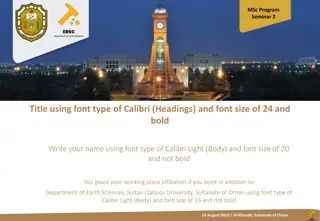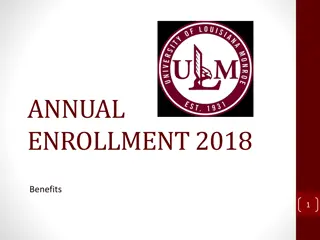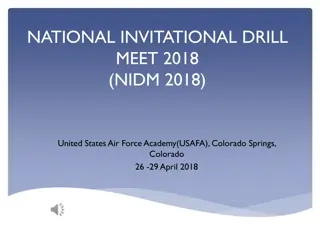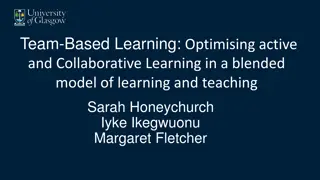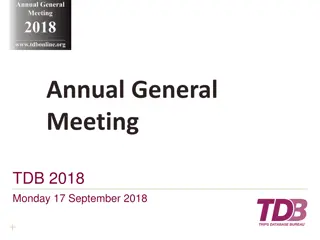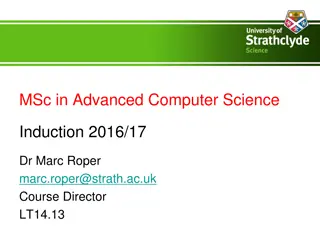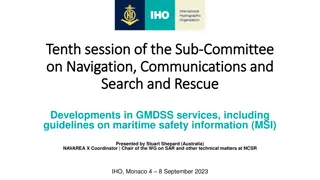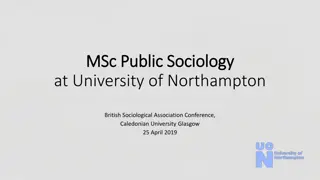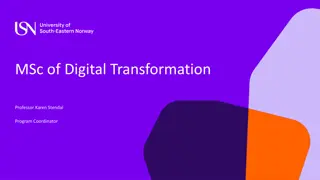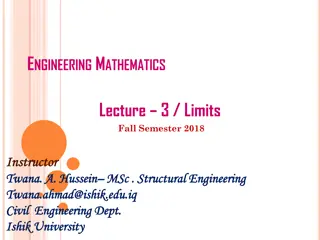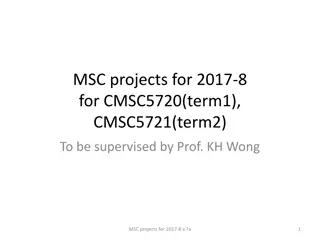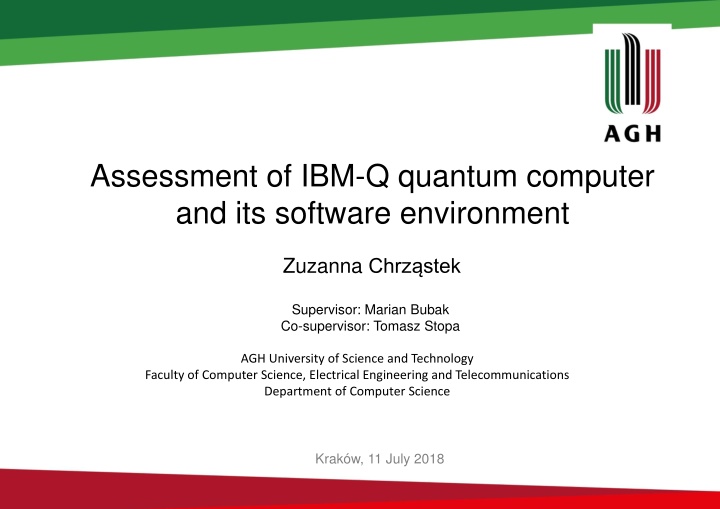
Assessment of IBM-Q Quantum Computer & Software Environment
"Explore the assessment of IBM-Q quantum computer and its software environment, including objectives, related work, hardware overview, and motivation. Discover insights into quantum computing and the IBM-Q system with proposed solutions and analysis of quantum algorithms."
Download Presentation

Please find below an Image/Link to download the presentation.
The content on the website is provided AS IS for your information and personal use only. It may not be sold, licensed, or shared on other websites without obtaining consent from the author. If you encounter any issues during the download, it is possible that the publisher has removed the file from their server.
You are allowed to download the files provided on this website for personal or commercial use, subject to the condition that they are used lawfully. All files are the property of their respective owners.
The content on the website is provided AS IS for your information and personal use only. It may not be sold, licensed, or shared on other websites without obtaining consent from the author.
E N D
Presentation Transcript
Assessment of IBM-Q quantum computer and its software environment Zuzanna Chrz stek Supervisor: Marian Bubak Co-supervisor: Tomasz Stopa AGH University of Science and Technology Faculty of Computer Science, Electrical Engineering and Telecommunications Department of Computer Science Krak w, 11 July 2018
Outline Motivation and objectives Related work Hardware of quantum computers IBM-Q devices and software environment QASM to the QuIDE converter Implementation of a quantum walk algorithm Summary and future work
Motivation Recently, quantum computing is becoming more and more popular [1]. IBM has built a quantum computer called IBM-Q, a universal quantum computing system for business and science [2]. There are other companies that build their own quantum computers, e.g. Google, D-Wave Systems, Rigetti Computing. It is impossible to transfer the style of programming from classical computers to their quantum counterparts [3] and therefore the role of quantum computers simulators rises. [1] Jop Bri t, Simon Perdrix. Quantum Computation and Information . ERCIM News 112 (Jan. 2018), pp. 8, 9. [2] IBM Q Experience Library . http://research.ibm.com/ibm-q/qx/. [3] Andris Ambainis, Harry Buhrman, Elham Kashefi, Adrian Kent, Iordanis Kerenidis, Frederik Kerling, Noah Linden, Ashley Montanaro, Floor van de Pavert and Thomas Strohm Quantum Software Manifesto (2017) http://www.qusoft.org/quantumsoftware-manifesto/.
Objectives Present physical background of quantum computing in IBM-Q. Gather information about architecture of IBM-Q. Analyze software environment of IBM-Q. Propose extensions to the IBM-Q software environment. Validate proposed solutions with different quantum algorithms. Assess the IBM-Q with a quantum walk algorithm. Methods Surveys for obtaining background information and for assessment of quantum computers and simulators. Case studies for analysis of quantum algorithms execution. Computer experiments for validation and evaluation of usability.
Related work Basic papers presenting physical background are: John Clarke and Frank K.Wilhelm. Superconducting quantum bits . Nature 453 (2008), pp. 1031 1042 Hans Mooij. Superconducting quantum bits . Physics World 17.12 (2004), p. 29. Solutions related to building software environments are presented in: Thomas H ner, Damian S Steiger, Krysta Svore, and Matthias Troyer. A software methodology for compiling quantum programs . Quantum Science and Technology 3.2 (2018), p. 020501 Joanna Patrzyk, Bart omiej Patrzyk, Katarzyna Rycerz, and Marian Bubak. Towards A Novel Environment for Simulation of Quantum Computing . Computer Science 16.1 (2015), p. 103. IBM-Q requires an enhancement with an advanced quantum simulator, that would show inner quantum states during execution of a quantum algorithm. This would help debugging quantum programs.
Superconducting qubits Qubit is a linearcombination | = ? |0 + ? State of a qubit can be manipulated by using unitary operators |? = ? represented as quantum circuits. Usage of Josephson junction [1]. Qubits are controlled by Rabi oscillations. If in time t=0 a qubit is in state |0>, the probability p01(t) of transition to state |1> in time t is described by formula: |1 , where?,? , ?2+ ?2= 1 |? , they can be A circuit representing a qubit (on the right) with Josephson junction that makes gaps between energy levels different from each other and voltage source to control the energy levels (we can use AC or DC voltage source). Frequency ?1is called Rabi frequency. [1] John Clarke and Frank K.Wilhelm. Superconducting quantum bits . Nature 453 (2008), pp. 1031 1042. DOI: 10.1038/nature07128. http://dx.doi.org/10.1038/nature07128.
IBM-Q basic element of the quantum computer The system consist of two layers: physical qubit layer that contains physical qubits controlled via a QEC processor, logical qubit layer through control of the physical layer. that functions The idea in quantum error correction is to encode information in subsystems of a larger physical space that are immune to noise.
IBM-Q architectures IBM-Q platform contains three types of backend architecture. Circles represent qubits while arrows show which qubit in a pair is a control qubit and which is a target qubit. IBMQX2 IBMQX4 IBMQX5
Basic parameters of IBM-Q Parameter IBM-Q s value Parameter General value IBM-Q s value Temperature of operation 15-20 mK 100 s 90 s Material Aluminium 10-100 ns 10 ns Critical temperature of aluminium Energy of Cooper pair for aluminum Dimensions of the device simulating one qubit 1.2 K Number of quantum operations 5 GHz 4-6 GHz 5 GHz About 500 m Quantum volume Topology Error rate The quantum volume V measures the useful amount of quantum computing done by a device in space and time: IBM QX 5Q 5x10-2 16 4x4 10-2 36 2 1 4x4 10-3 256 ? ?min ? , ? = max ? ????? 7x7 10-3 256 7x7 10-4 1296
Software environment of IBM-Q (1/2) There are several ways to create a quantum program to be executed on IBM quantum computer: graphical user interface (GUI), software development kit called Quantum Information Software Kit (QISKit), both circuit elaborated with the GUI and QISKit code can be translated into QASM code, directly in QASM.
Software environment of IBM-Q (2/2) Extract from a table with quantum operators, their counterparts set of functions and IBMQ Composer s representations. The whole table is in the thesis. Operator QISKIT function IBM-Q gates in QISKit s h(q[i]) gates s(q[i]) t(q[i]) measurement measure(q[i],c[i])
Comparison of IBM-Q and QuIDE simulators IBM-Q IBM-Q QISKIT Non-elementary quantum gates QuIDE GUI and QASM Only elementary quantum gates Graphical interface and assembler Ability to create quantum programs with code (QASM or Python QISKit framework) as well as with Composer Non-elementary quantum gates C# (.NET Framework) Python Ability to create quantum programs with code (C# - QuIDE library) as well as with Circuit Designer Shows values of registers, probability and amplitude after each step of circuit execution Shows results after execution of the whole circuit One library Multiple frameworks Transformation from code to circuit and vice versa Ability to create reusable subroutines
QASM to QuIDE converter The converter converts QASM code (transcript of a quantum circuit) to C# code that can be run on QuIDE simulator. QuIDE gives the user a possibility to preview the internal state of a quantum system at each stage of the computation. This is impossible on real quantum systems as well as on IBM's simulator.
QuIDE and IBM-Q functions mapping QISKIT function QASM function QuIDE function h(q[i]) h q[i] q.Hadamard(i) s(q[i]) s q[i] q.PhaseKick(Math.PI/2, i) t(q[i]) t q[i] q.PhaseKick(Math.PI/4, i) measure(q[i],c[i]) measure q[i]->c[i] q.Measure(i) Extract from the table shows quantum gates as QISKIt functions, their counterparts in QASM and finally the mapping to functions in QuIDE. The whole table is in the thesis.
Validation of QASM to QuIDE converter (1/3) The converter was validated with the Deutsch-Jozsa algorithm, the Grover algorithm and the Shor algorithm in the following way: The existing circuits were transformed in the IBM-Q into a QASM code which was then converted into a C# code in the converter. From the C# code a circuit in the QuIDE was generated. We compared the circuit from the IBM-Q and the circuit from the QuIDE. If they were identical, it was a proof that the conversion is correct. The next step was to check internal states in the key stages of the examined algorithm. Finally, we compared results from both simulators as well as from the real IBM-Q processor. Deutsch-Jozsa quantum circuit in IBM-Q Composer Deutsch-Jozsa quantum circuit in QuIDE Circuit Designer
Validation of QASM to QuIDE converter (2/3) QuIDE results IBM-Q results The results of executing the Deutsch-Jozsa algorithm from the QuIDE simulator and from the IBM-Q simulator. More examples in the thesis.
Validation of QASM to QuIDE converter (3/3) QuIDE circuit stopped in the middle Quantum circuit in the QuIDE's circuit designer tool generated from the C# code that was converted from QASM code of the Deutsch-Jozsa algorithm "stopped" after step 3 of the algorithm. QuIDE results from the state where the algorithm was stopped
Quantum random walk algorithms (1/5) Stochastic process that describes a path derived from a series of random steps on some mathematical space [1]. A walker is placed at 0 on a line of integers and a coin is flipped. Depending on which side it lands, the walker moves one unit to the right or one unit to the left. |??, |? = ?[?? |1?] |0?+ ?? where |0?, |?? are the walker state components. |1? are the coin state components, [1] Radhakrishnan Balu, Daniel Castillo, and George Siopsis. Physical realization of topological quantum walks on IBM- Q and beyond . Quantum Science and Technology 3.3, 2018, p. 035001
Quantum random walk algorithms (2/5) Stochastic process that describes a path derived from a series of random steps on some mathematical space. A walker is placed at 0 on a line of integers and a coin is flipped. Depending on which side it lands, the walker moves one unit to the right or one unit to the left. [1]. [1] Radhakrishnan Balu, Daniel Castillo, and George Siopsis. Physical realization of topological quantum walks on IBM-Q and beyond . Quantum Science and Technology 3.3 (2018), p. 035001. http://stacks.iop.org/2058-9565/3/i=3/a=035001.
Quantum random walk algorithms (3/5) Basic gates Increment gate Decrement gate
Quantum random walk algorithms (4/5) Implementing this algorithm in QISKit was not trivial, because the cccNOT gate had to be decomposed to elementary gates that QISKit would be able to read. Quantum walk on three qubits, with a 2-qubit walker. Parameters of U3 gates are ? converted to double. 4, ? 2,? 2 One step of a quantum walk with a 3-qubit walker, implemented in the IBM-Q simulator.
Quantum random walk algorithms (5/5) Implementation on both the IBM-Q simulator and the QuIDE simulator as well as on the IBM-Q real backend. Results from the IBM-Q simulator are very similar to the results from the QuIDE. The results from the IBM-Q simulator and the real backend differ significantly. The reason for that is decoherence.
Assessment of usability of IBM-Q After a number of gates decoherence significantly interrupts executing of algorithms. Lack of tools that can help with mapping quantum algorithms to topologies of the IBM-Q backends. The graphical interface is quite limited. QISKit provides more gates than the graphical interface, nevertheless we needed cccNOT gate which is not available in QISKit. In QISKit we can also use standard Python instructions such as loops, which significantly speeds up the process of implementation. QISKIT provides tools for creating histograms. For debugging purposes, it is useful to visualize the quantum state.
Summary We presented realization of qubits in superconducting quantum computing. Architectures of the IBM-Q and its parameters were delineated. We described software environment of the IBM-Q, its features and their applications. We presented our idea for an extension of the IBM s simulator. We implemented and executed a quantum walk on both the IBM-Q and the QuIDE simulators as well as on the real quantum processor of IBM. The thesis showed the importance of quantum simulators, validated the IBM-Q quantum computer and reviewed some available quantum algorithms.
Future work Decoherence analysis, especially its impact on the state of the system during usage of multiqubit gates. Investigation of optimal placement of selected quantum algorithms on the IBM-Q architectures. Paper [1] presents a concept of a software architecture for transformation quantum programs from a hardware-specific instructions. This may be considered as a program for further investigations. high-level language program to [1] Thomas H ner, Damian S Steiger, Krysta Svore, and Matthias Troyer. A software methodology for compiling quantum programs . Quantum Science and Technology 3.2 (2018), p. 020501
Final remarks This research has been done in collaboration of the Department of Computer Science AGH with the IBM Lab Krakow We acknowledge Dr Katarzyna Rycerz and Prof. Piotr Gawron (IITiS PAN Gliwice) for their suggestions and discussions The thesis and this presentation are available at http://dice.cyfronet.pl/publications/filters/filter_MSc_Theses We plan to present the results of this Thesis at the CGW 2018 as two short papers: Interoperability of the IBM-Q and QuIDE simulators Implementing and running a quantum walk on the IBM-Q

